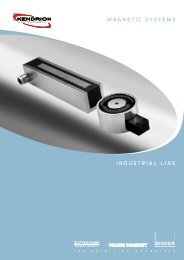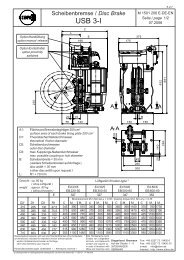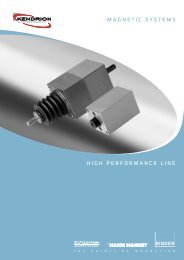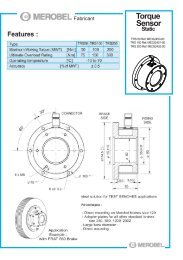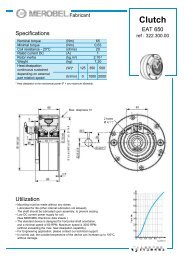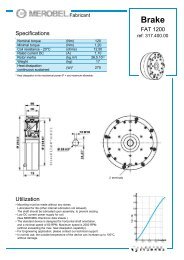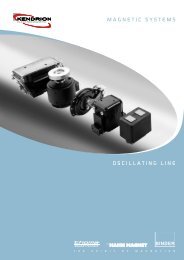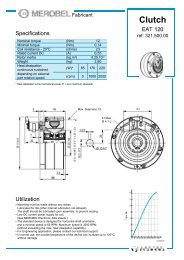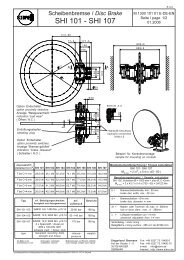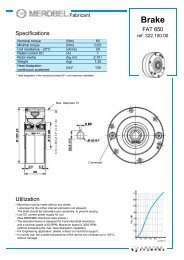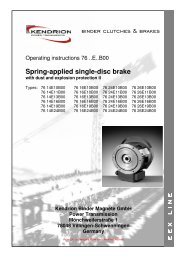catalog active brake line - Magnet Service Binder
catalog active brake line - Magnet Service Binder
catalog active brake line - Magnet Service Binder
You also want an ePaper? Increase the reach of your titles
YUMPU automatically turns print PDFs into web optimized ePapers that Google loves.
General technical information<br />
<strong>active</strong> <strong>brake</strong> <strong>line</strong><br />
Product <strong>line</strong> information<br />
<strong>active</strong><br />
<strong>brake</strong><br />
The ACTIVE BRAKE LINE is<br />
comprised of DC operated<br />
single-disc <strong>brake</strong>s where the<br />
dynamic effect of an electromagnetic<br />
field is used to<br />
generate the braking effect<br />
(electromagnetically<br />
engaged <strong>brake</strong>s). ACTIVE<br />
BRAKE LINE products ensure<br />
a reliable <strong>brake</strong> release<br />
with zero residual torque in<br />
any mounting position and<br />
zero backlash during torque<br />
transmission. These <strong>brake</strong>s<br />
require little maintenance<br />
throughout their entire<br />
service span.<br />
Versions<br />
binder clutches & <strong>brake</strong>s<br />
86 111..E00 torque range 1 - 150 Nm<br />
DC<br />
front mounting<br />
86 121..E00 torque range 1 - 60 Nm<br />
DC<br />
flange mounting<br />
Upon request, the <strong>brake</strong> can be supplied with variable<br />
armature systems (shaft coupling).<br />
<strong>line</strong><br />
Applications<br />
• Automotive technology<br />
• Equipment manufacturing<br />
industry<br />
• Handling technology<br />
• Building installations<br />
• Medical technology<br />
• Packaging machinery<br />
• ...<br />
Information on technical data included in the data sheets<br />
The information provided in the<br />
operating instructions must be<br />
strictly adheared to when<br />
designing a machine<br />
(e.g. motor) and when using<br />
the <strong>brake</strong>s. The <strong>brake</strong>s are<br />
manufactured and tested in<br />
compliance with DIN VDE 0580<br />
requirements. The insulation<br />
materials used conform with<br />
thermal class F norms.<br />
Operation of the <strong>brake</strong> as a<br />
pure holding <strong>brake</strong> without<br />
friction work is only permitted<br />
after prior consultation with the<br />
manufacturer. The specified<br />
times apply to the following<br />
conditions: seperate switching<br />
of the <strong>brake</strong>, operating<br />
temperature, rated voltage, and<br />
rated air gap. All values are<br />
mean values that are subject to<br />
variation. In case of AC <strong>brake</strong><br />
switching, the coupling time t 1<br />
is substantially longer. W max<br />
(maximum switching energy) is<br />
the switching energy that must<br />
not be exceeded during<br />
braking operations at max.<br />
1000 rpm. Braking operations<br />
at >1000 rpm lead to a<br />
substantial reduction in the<br />
maximum admissible switching<br />
energy per switching operation.<br />
Such operation is only<br />
permitted after prior consultation<br />
with the manufacturer.<br />
The maximum switching power<br />
- 5 -<br />
P max is the switching energy W<br />
that can be converted by the<br />
<strong>brake</strong> per hour. In the case of<br />
applications where the number<br />
of switching operations per<br />
hour is greater than 1 (Z>1), the<br />
diagram (W max as a function of<br />
the number of switching<br />
operations per hour Z) shown<br />
in the operating instructions<br />
applies. The P max and W max<br />
values are approximate values.<br />
The specified rated torques M 2<br />
characterise the torque level of<br />
the <strong>brake</strong>s. Depending on the<br />
application of the <strong>brake</strong>, the<br />
switching torque M 1 and the<br />
transmissible torque M 4 may<br />
differ from the specified M 2<br />
values. The switching torque<br />
M 1 depends on the speed<br />
(rpm). If the friction surfaces<br />
are contaminated with oil,<br />
grease or dirt the transferable<br />
torque M 4 and the switching<br />
torque M 1 may drop.<br />
All technical data is subject to<br />
the running-in process of the<br />
<strong>brake</strong> being completed.<br />
<strong>active</strong> <strong>brake</strong> <strong>line</strong>



